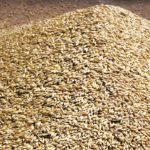Reading Time: 2 minutes MarketsFarm — Depending on whom one has spoken with, there are differing views as to grain exports to China other than canola. The federal government has stated there have been no export issues outside of canola. “The current actions taken by China are limited to canola seed, and we have not received any indication of […] Read more

Views differ on crop exports to China other than canola

Four tips for better barley production
Four tips to better barley production Whether or not you’re using variable rate technology in your malting barley crop, it is important to use due care and attention when establishing the cereal crop, say two long-time Agriculture and Agri-Food Canada researchers. John O’Donovan, now retired malting barley agronomist ,and Kelly Turkington, a plant pathologist with[...]
Read more
Read more

Feed weekly outlook: Barley prices correct off recent highs
Reading Time: < 1 minute MarketsFarm — Feed markets in Western Canada have softened slightly following a jump in prices earlier this month. Nelson Neumann, a grain trader for Agfinity, said barley supply was tight earlier in the month as buyers rushed to secure their feed before spring road bans, seeding season and poor weather conditions hampered deliveries. “We saw[...]
Read more
Read more

Sorting out the stacks
New research in Alberta suggests big yield gains for wheat when combining some agronomic practices — especially dual fungicide applications
Reading Time: 6 minutes Farmers experiment with their agronomic practices all the time. It’s not uncommon to see them “stack” inputs, for instance by combining fertilizer, plant growth regulators (PGRs) and fungicides to see which combinations boost their yields. But until recently, there has been little in the way of small-plot research into the yield potential of stacking agronomic[...]
Read more
Read more

Klassen: Feeder market holds value
Reading Time: 2 minutes Western Canadian feeder cattle prices were relatively unchanged compared to seven days earlier. Buying interest for yearlings was somewhat stronger while calves in the eastern Prairie regions were softer. Moderate temperatures are in the seven-day forecast for most of Western Canada, so the risk discount due to adverse weather has evaporated. Barley jumped an additional[...]
Read more
Read more

Klassen: Feeder market sends mixed signals
Reading Time: 2 minutes Compared to last week, western Canadian yearling markets were steady to $4 lower while calves were steady to $2 higher. Barley prices have jumped $3-$6 per tonne over the past week, with winter conditions hindering off-farm logistics. Alberta packers were buying fed cattle in the range of $149-$150 last week; however, in Nebraska, fed cattle[...]
Read more
Read more

Canola exports still sluggish, but grains solid
Reading Time: < 1 minute Canadian canola exports continue to lag behind the year-ago pace, with large supplies in the commercial pipeline, according to the latest weekly data from the Canadian Grain Commission. Canada only exported 69,900 tonnes of canola during the week ended Sunday, well below the 205,500 tonnes that moved the previous week. Total canola exports during the[...]
Read more
Read more

Barley ‘price war’ seen sparked by China, Saudi demand drop
Reading Time: 2 minutes Paris | Reuters — A drop in demand from China and Saudi Arabia sent barley prices tumbling in recent weeks, despite low global supply, and price pressure may continue if harvest prospects for next season remain good, analysts at Strategie Grains said. The barley market rallied earlier in the 2018-19 season with weather-hit crops in[...]
Read more
Read more

Feed weekly outlook: Markets steady amid cold Alberta weather
Reading Time: < 1 minute Excessively cold temperatures in Alberta may be causing headaches for both feed grain buyers and sellers, but prices remain relatively steady for what’s moving. The cold weather hasn’t really led to a significant increase in demand, but “it’s definitely made the farmer grumpy,” said Brandon Motz of CorNine Commodities in Lacombe, Alta. “In general, the[...]
Read more
Read more

Feed weekly outlook: Tight supplies, good demand support barley
Reading Time: < 1 minute Solid demand, both domestically and internationally, coupled with tightening world supplies is keeping barley bids well supported in Western Canada and should lead to increased acres this spring. “The price of feed barley is staying historically high,” said Brian Otto, chair of the Barley Council of Canada, noting feed barley at Lethbridge was currently trading[...]
Read more
Read more


